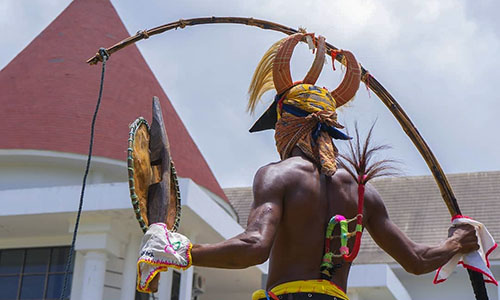Manggarai Ethnic Culture

The Manggarai ethnic culture is a tribe culture that involves the life of the Western part of Flores island. The Manggarai ethnic group is speared into 3 main districts in East Nusa Tenggara province, Indonesia.
Here is the main district of Manggarai in the province of Nusa Tenggara:
- West Manggarai Regency
- Manggarai Regency
- East Manggarai Regency
According to history, Manggarai ethnic was controlled under the Bima tribe from Sumbawa island and Makassar from Sulawesi island. There were around 500.000 Manggarai people in the late 20th century.
The Traditional Rituals
Manggarai ethnic has some traditional ritual series ceremonies. It is intended as the Thanksgiving of life during a certain period of time.
There are some traditional rituals which commonly celebrate in Manggarai ethnic groups, such as Penti, Caci, and many more. The biggest event in the Mangarai tradition is Penti and the most popular traditional dance is Caci.
The strong characteristic of the tradition of Manggarai people could be found on every island they live on. They are most show up their tradition in every place they live, such as in Java, especially in Jakarta.
What is Penti?
Penti is a traditional ceremony of the Manggarai ethnic which has noble meaning. Penti intended as a thanksgiving to God and the Ancestors for the harvest of the year they have.
The ceremony is also meant to gather the families of the village and the ones who have lives outside. On the other hand, Peniti is also intended to build a strong relationship with each person in the family. They are praying together, celebrating, and asking for peace between the families and villagers.
Here are some of the rituals during the Penti Ceremony:
- Barong Lodok is a ritual that invites the guardian spirit to the center of Lingko (the center of the farm).
- Barong Compang is intended to invite the ancestor spirit (Empo) to take part in Penti ceremony at night.
- Barong Wae is a ritual to remember the place where the ancestors were taking bath or shower. Invite the spirit of Empo (ancestors) to have a shower. And let them remember that this is the river where they were having a shower.
- Barong Boa means a ritual to visit Graveyard, praying and inviting the Empo (ancestors) or those who have died.
- Libur Kilo is a reunion ritual for a family, Thanksgiving.
- Wisi Loce is a ritual that stretches the mat for the spirit of ancestors (Empo). Let them have a rest before going to the main Penti ceremony.
What is Caci?
Caci is the Manggarai ethnic traditional whip fighting. Caci normally comes together with the Penti rituals. This is a very sacred event for the Manggarai ethnic community. Caci also performs in some ceremonial, such as Weddings, greeting the Government Official.
Caci is performed by groups of men from different villages. Each man fights against one man from the other opponent. You may join our Caci Whip Fighting Tour to see more details.
Equipment used in Caci dance and whip fighting:
- Larik is a dry buffalo leather strap with a length of around 50cm. It is tied well with a rattan stick about 50cm long as well.
- Panggal is a head protector that shapes like a buffalo horn.
- Nggiling or Toda is a shield to protect against the opponent's attack. It is made from dry buffalo skin with a diameter of 2 x 50cm. It is a circle and there is wood in the middle to hold.
- Koret is also a piece of counter-attack equipment, curved and a length of 3 meters. It is made from a dry rattan.
- Nggorong is the bell that puts in the waist and it makes a sound accompaniment to the dancer.
A man who joined this Caci fight must be dressed in a traditional costume, such as the following:
- Towe Congke (traditional material).
- White long pants.
- Sapu Tangan (handkerchief).
- Selendang (shawl).
There are still many traditions in Manggarai. We need more time to look at and find out the history.
Mbaru Adat Manggarai/Traditional Houses
The traditional houses of Manggarai are well known as Mbaru Gendang/Mbaru Niang. It has spread everywhere in Manggarai.
Mbaru Gendang is used for sacred rituals of meetings such as Penti ceremonials, wedding rituals, and many more.
The Manggarai traditional houses are made from the following materials:
- Haju is wooded for Tiang(pylon) and wall.
- Wunut is palm fiber for the roof.
- Rangga Kaba is a buffalo horn. It is a symbol of strength and is located on the top roof of Mbaru.
There are some villages that are still kept original to the traditional houses of Manggarai:
- Mbaru adat Ruteng Pu'u/ Ruteng Pu'u traditional houses
- Bangka Tuke Traditional Houses
- Mbaru Adat Todo/ Todo traditional houses.
- Wae Rebo traditional houses.






